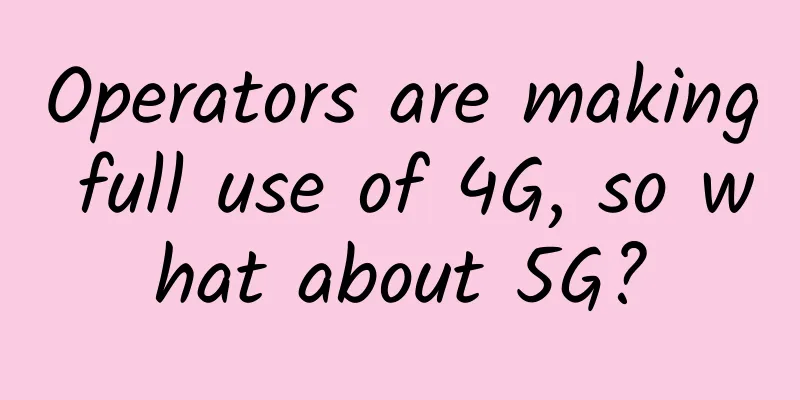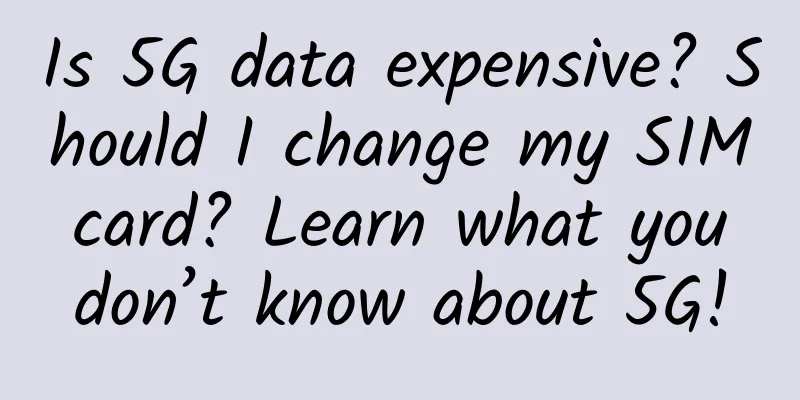Operators are making full use of 4G, so what about 5G?

|
In the early stage of 4G development, the dividends brought by population and traffic once made operators enjoy the pleasure of eating the front abbot. Unfortunately, now the weak income growth and the increase in network maintenance costs have brought huge pressure to operators, and "increasing volume but not increasing revenue" has become an inevitable reality for operators. As this market has become a red ocean, let us first take a look at what the operators have experienced in the 4G era.
Early 4G period: some missed the opportunity while others took the lead As early as the early stages of 4G development, China Mobile took the lead in promoting the 4G brand and actively promoted 4G commercial use.
Since China Unicom was allocated the largest WCDMA network in the 3G era, it did not invest heavily in 4G infrastructure in the early days of 4G. Despite the aggressive approach of competitors, China Unicom still built 160,000 3G base stations in 2014, but only built 93,000 4G base stations. China Unicom upgraded its 3G network to 42M and developed users with the "3G/4G integration" plan. In terms of marketing, it used contract phone package discounts and free data for stock upgrades to attract users. In terms of package settings, it mainly promoted 9 levels of 4G national packages, 4G combination packages that allow users to purchase voice packages, data packages, and SMS packages separately according to different needs, and local packages including provincial data. China Telecom was quite cautious about 4G, and did not officially launch 4G marketing until the FDD trial license was issued in early 2015. Telecom mainly promoted the Enjoy 4G package, 4G Building Block package and 4G pure data cloud card, and combined the advantages of fixed network to create the "4G double 100M" marketing slogan. However, due to the limitation of CDMA network standard, the number of 4G terminals supporting Telecom package is very small, which has buried a hidden danger for Telecom's 4G development. Although China Telecom and China Unicom hoped to develop their business by combining their own advantages in the early stage of 4G, they did not expect that within a few months of hesitation, they would quickly open up a huge gap with China Mobile's 4G development. As of 2015, China Mobile's 4G users have reached 300 million, while China Unicom, which relies on 3/4G hybrid network development, has only 44 million 4G users, and China Telecom, which is limited by the network standard, has only 58 million 4G users. In terms of revenue, the total profit of China Telecom and China Unicom combined is less than 30% of China Mobile's. Such a huge gap makes both China Unicom and China Telecom sweat. Later stage: Start the battle of grabbing users with low-priced packages In order to seize more market share and save its own income, China Unicom took the lead in launching daily rental cards in August 2016. The slogan of "500M for 1 yuan, no need to spend" brought a huge impact on traditional 4G packages. China Telecom followed suit and launched the "Tianyi Daily Rental Card" with a daily rental of 800M for 1 yuan. In March 2017, China Unicom took the lead in launching the unlimited data "Ice Cream Package". Compared with the 4G packages with fixed data quotas, the unlimited data package allows users to save data without being cautious about saving data, fearing that a picture or a video will cause the package data to exceed the limit. In May of the same year, China Telecom also launched an unlimited data package, and combined the advantages of fixed networks to bundle fiber broadband and high-definition TV to form a fusion package, and used the marketing method of giving away secondary cards to quickly occupy the family market that can develop multiple users at one time. In 2017, China Unicom once again innovated and actively cooperated with Internet companies to launch the first "Internet card" - Tencent King Card. The biggest advantage of this Internet card is that it can be used to waive the flow of various apps under Tencent, so that users do not need to trigger the daily rental flow in many cases, and can even be exempted from the flow charge. Taking advantage of Tencent's strong Internet appeal, Tencent King Card was quickly promoted and spread among users, turning China Unicom's net increase in users from negative to positive, and becoming a landmark product in mobile phone packages. At present, China Unicom and China Telecom have launched more than 130 types of Internet cards. In the context of cooperation with Internet companies, operators can quickly expand their user base and use the advantages of Internet companies to achieve twice the result with half the effort in publicity. As of the end of 2017, China Unicom had 175 million 4G users, and China Telecom had 182 million 4G users. Although these numbers are dwarfed by China Mobile's 650 million, the two operators have emerged from their difficulties and opened up a new path. After 5G commercialization: What can operators do In the 4G era, operators racked their brains to "sell traffic", from daily rental cards that do not deduct fees when not used to targeted video traffic, and then to unlimited traffic that can be used at will. However, with the development of video applications, games, and e-commerce, users in the 5G era will have an increasing demand for traffic. In 2017, the average monthly traffic of mobile users in my country reached 1.77GB, 2.3 times that of 2016, and this data reached 2.75GB in December 2017. According to relevant agencies, by 2020, global mobile data traffic will increase to 8 times that of 2015, and the average traffic per household will exceed 4GB/month. Faced with the rapid growth of user traffic and the homogeneity of product competition, what changes can operators who do not want to become "plumbers" do?
Future: 5G commercial market is worth a try Although the cost of 4G has not been recovered, and the dilemma of increasing volume but not increasing revenue is tiring, operators have to step up their efforts to build 5G, because consumers will only choose faster and better network experience, and if they hesitate, it may be difficult to catch up. With the advent of the 5G era, the operator market structure may be subverted again, which makes us look forward to the coming era. |
<<: The struggle between operators and users: Who decides my package?
>>: Five signs SCVMM isn't right for your data center
Recommend
Starting from a large amount of real data, we analyze the employee remuneration of China Unicom
China Unicom released its 2020 performance report...
OneTechCloud offers 10% off on all items, US CN2 GIA high-security VPS with monthly payment starting from 31 yuan
OneTechCloud has released this month's promot...
After unplugging the network cable, does the original TCP connection still exist?
Hello everyone, I am Xiaolin. Today, let’s talk a...
Major upgrade! AsiaInfo Security releases the high-performance AE 40G antivirus software, creating the first level of border protection
At 2 pm on April 17, AsiaInfo Security's AE V...
The ultimate secret to speeding up WiFi is here!
The previous two WeChat articles "Your offic...
10 common data center operation and maintenance errors that can cause panic
Some common sense mistakes can reduce the data ce...
Challenges remain in the large-scale development stage of 5G applications
A recent investigation by reporters found that in...
Countries are launching alliance strategies to compete for the right to formulate 6G standards
As many countries have suffered losses in the pac...
AlphaVPS: Bulgaria dedicated servers from €39/month, Los Angeles/Bulgaria VPS hosting from €2.99/month
AlphaVPS is a foreign hosting company founded in ...
Sharktech: Los Angeles high-defense servers starting at $59/month, 1Gbps unlimited traffic
Sharing information about several high-defense se...
G Suite vs. Office 365: Which is the right productivity suite for your business?
Choosing an office suite used to be a simple matt...
CloudCone: $9.5/year-512MB/30GB/3TB@1Gbps/Los Angeles data center
Updated again, CloudCone's Christmas promotio...
Green operation, data center still depends on automation
Power is the lifeline of data centers, and electr...
The importance of 5G for manufacturing robots
The use of robots is often associated with the pu...
Configuring 802.1x Remote Authentication
Topology Specification Applicable to all versions...








![[Black Friday] Zgovps: $12.9/year-1GB/20GB/2TB/Japan IIJ/Germany/Los Angeles AS4837, etc.](/upload/images/67cabcf94e758.webp)
